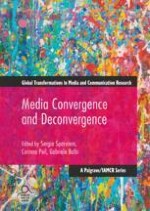This edited volume explores different meanings of media convergence and deconvergence, and reconsiders them in critical and innovative ways. Its parts provide together a broad picture of opposing trends and tensions in media convergence, by underlining the relevance of this powerful idea and emphasizing the misconceptions that it has generated. Sergio Sparviero, Corinna Peil, Gabriele Balbi and the other authors look into practices and realities of users in convergent media environments, ambiguities in the production and distribution of content, changes to the organization of media industries, the re-configuration of media markets, and the influence of policy and regulations. Primarily addressed to scholars and students in different fields of media and communication studies, Media Convergence and Deconvergence deconstructs taken-for-granted concepts and provides alternative and fresh analyses on one of the most popular topics in contemporary media culture.
Chapter 1 is available open access under a CC BY 4.0 license at link.springer.com
